
| Tourist Information - Mysore in and around | ||
KARNATAKA, the 8th Largest State in the Indian Union. Its history dates back to the 3rd Century BC. The succession of able administrators from the Hoysalas, Chalukyas and the mighty Vijayanagara rulers, to the arrival of the Mughals in the 17th century and the British in the 18th Century have contributed to the mix of culture and heritage that is as rich as it is ancient; Is a veritable treasure trove of tourist hill delights with dazzling array of the ancient sculpted temples, modern cities, friendly people, scenic hill ranges, unexplored forests and endless beaches, a land as fragrant as the sandal wood trees grown in abundance here, a place that has all the ingredients for a great holiday, a pleasant hill station climate, an incredible choice of shopping delights including silk, spices and handicrafts, an environment where English, Kannada, Hindi are spoken with equal ease. |
||
| The state is well connected with all major cities in India by air, road and rail. Each spot in Karnataka has something unique to offer. | ||
| Area | : |
385.129 km² (50 sq mi) |
| Population | : |
30 lacks app in mysore district 10 lakhs aproximately in mysore |
| Constiuency | : |
04 |
| Taluks | : |
28 |
| Temperature Summer | : |
Max 34° C Min 21°C |
| Temperature Winter | : |
Max 30°C Min 12°C |
| Rainfall | : |
80 cms. Average yearly |
| Best Time to Visit | : |
October to March |
| Languages | : |
Kannada, Hindi, English, Urdu |
| Local Transport | : |
City Bus Services
Transport within the City is Provided by the KSRTC Town Bus Services, Connecting Different Parts of the City and Suburbs. City Bus Stand Tel : 0821 - 2425819 Suburban Bus Stand Tel : 0821 - 2520853 |
| Currency | : |
Indian Rupee |
| Religions | : |
Hinduism, Islam, Christianity and Jainism |
| Climate | : |
|
| Pincode | : |
570 0xx |
| Telephone | : |
+0821 |
| Vehicle | : |
KA - 09 |
Lush green, picturesquely located 750 m above sea level, Mysore is located at a distance of 140 km to the south west of Bangalore. Known for its magnificent palaces and majestic buildings, sprawling gardens and treelined boulevards, shimmering silks and sandalwood, the ‘City Royale’ always figures in the tourist’s itinerary. It conjures up visions and memories of the resplendent glory of the illustrious Wodeyar Kings. This former state capital is a seamless blend of old-world charm and modernity. It retains its tradition in music and dance, art and literature, and time-honoured crafts |
||
Mysore Palace Built in Indo-Saracenic style, with domes, turrets, arches, and colonnades, the palace is a treasure house of exquisite carvings and works of art from all over the world. Known as Amba Vilas Palace, it was designed by Henry Irwin, the British consultant architect of Madras state, and completed in 1912 on the site of the old wooden palace that was destroyed by fire in 1897. The majestic Durbar Hall with its ornate ceiling and sculpted pillars, and the Marriage Pavilion with its chandeliers, cast-iron pillars, and Belgian stained glass arranged in peacock designs in the domed ceilings are the main attractions. Make sure you see the magnificent jewel-studded golden throne, the pride of the Wodeyars and the symbol of their sovereignty, displayed here during the Dussehra festival in October. |
 |
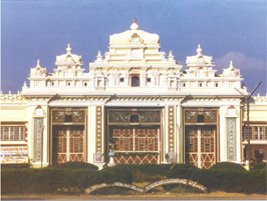 |
Sri Jayachamarajendra Art Gallery |
St. Philomena's Church A beautiful Cathedral St. Philomena's Church, built in imposing Gothic style with stained glass windows and lofty towers is a truly majesticsight. Never missto see the illuminated church in the evening. The church was consecrated on 28th October 1956. |
 |
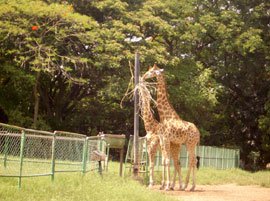 |
Zoological Garden Sri Chamarajendra Zoological Gardens was established in 1892. Maharaja Chamaraja Wodeyar, one of the architects of modern Mysore, established the Zoological Garden. He was a lover of nature and was responsible for creating many parks and gardens. The Zoo Garden was created in a portion of the Summer Palace or Pleasure Palace in the eastern part of Mysore City. Initially, the Zoo covered an area of 10 acres of the Summer Palace. The Maharaja engaged the services of Mr. G.H. Krumbeigal, German landscaper and horticulturist, who had created the beautiful and the famous Brindavan Gardens in Krishnarajasagar and the Cubbon Park in Bangalore. It is considered as one of the best in India and ranks high in zoological circles as a major archive in conservation of wild life. It is situated at the foot of Chamundi Hill. It has beautiful landscape and good vegetation cover resembling that of natural environment. It has to its credit the breeding of rare animals and largest mammals in captivity. Hence, it is grouped under `A' class category zoos in India. The Mysore Zoo is famous for rare animals bred in captivity, which are housed in lush, green surroundings. This zoo has about 35 species of ornamental plants and 85 species of trees from India and abroad beautifying the landscape of the zoo, thus providing the most natural environment to the captive animals. It is home to some 2,000 animals belonging to different species, fascinating among them being the royal Bengal tigers, giraffe, Indian and African elephants, white tiger, lions, rhinos, Nilgiri langur, Himalayan brown bears, hippopotamus, peacock, parakeet and others. The Zoo Authority of Karnataka manages the zoo. Timings: 8.00 a.m. to 5.00 p.m. Open daily, except on Tuesdays. |
Rail Museum The Railway Museum at Mysore, India is an outdoor exhibit of vintage locomotives. It was setup in 1979 by Indian Railways and is the second such museum after the National Railway Museum in Delhi. The museum is situated opposite the Central Food Technology and Research Institute on Krishnaraja Sagar road. In addition to the locomotives it has a gallery of photographs and paintings depicting the growth of railways in India. Railway signals and lights are also displayed. The museum also has a battery-operated mini-train for children which makes a small ride in the grounds of the museum. |
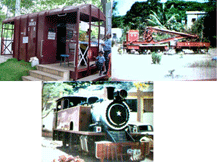 |
 |
Regional Museum of Natural History The Regional Museum of Natural History at Mysore, was inaugurated on 20th May 1995. It was undertaken by the Government of India, Ministry of Environment and Forests. The museum is located on the banks of Karanji Lake, with the Chamundi Hills visible in the background. It is now a landmark in the city. The museum exhibits Plants, Animals and Geology of the Southern Region of India. The galleries emphasize the conservation of nature and natural resources while depicting ecological interrelationship among plants and animals. Visually challenged students can feel the exhibits of animals on the premises. The museum provides an extracurricular activity for schools and promotes environmental awareness. |
Folklore Museum This small museum located in the Mysore university campus in the Manasagangothri campus in the The Jayalakshmi Vilas Mansion. north-east of the city centre. The museum was founded in 1968. Among the exhibits is a superb collection of carved wooden figures from Karnatakan villages, decorative masks and ceremonial head wear and a display of leather shadow puppets used to perform stories from the Ramayana and Mahabharata - similar to the wayang Kulit of Java in Indonesia. There are also wooden puppets, including one of a 10 - headed demon Ravana. As a folklore museum it not only showcases items but also elements of music, dance and drama. |
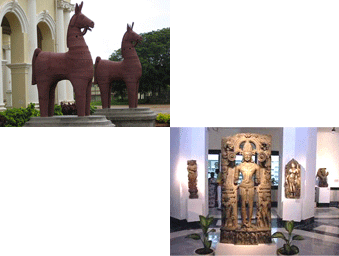 |
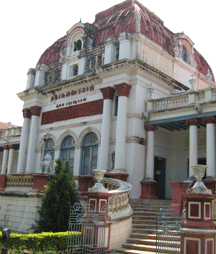 |
Oriental Research Institute The Oriental Research Institute (ORI) at Mysore, is a research institute which collects, exhibits, edits and publishes rare manuscripts in both sanskrit and kannada. Formerly it was known as the Oriental Library. The Oriental Library was started in 1891 on instructions from Chamaraja Wodeyar, the then Maharaja of Mysore State. It is located at one end of the road Krishnaraja Boulevard, in the architecturally attractive Jubilee Hall built in 1887 to commemorate the golden jubilee of queen Victoria`s accession to the British throne. It was a part of the Department of Education until 1916, in which year it became part of the newly established University of Mysore. The Oriental Library was renamed as the Oriental Research institute in 1943. |
Karanji Nature Park Known for its thousands of different varieties of Butterflies. This is also know as butterfly park.Karanji Lake situated on the way to Chamundi Hills behind Mysore Zoo, houses the first & biggest aviary and also the first butterfly park. Karanji Lake is often visited for boating facilities available for one and all. This lake is open for public on all days except Tuesday between 10 am to 6 pm. It is advisable that visitors should insist on wearing lifesaving jackets while opting for boating facilities. |
 |
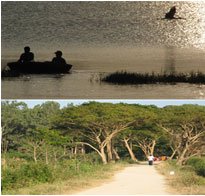 |
Kukkarahalli Lake Kukkarahalli Lake , Amidst Manasa Gangothri campus, situated is a beautiful lake, which is frequently visited by bird watchers, health conscious people and nature lovers. This lake is also visited by varieties of migratory birds during winter and to watch those birds is feast to ones eyes. The lake is very near to the railway station and bus stand. |
Brindavan Gardens. |
 |
 |
Balmuri |
Chamundi Hills |
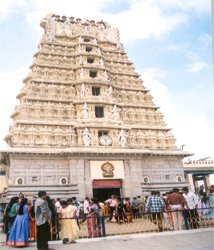 |